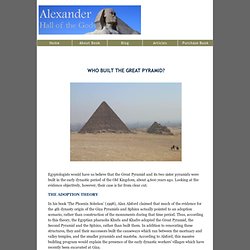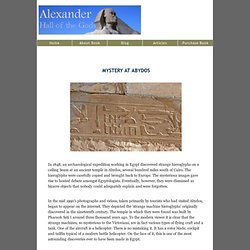

House of Fun sur Facebook. House of Fun sur Facebook. WWII. Archaeological sites. British History. Ancient Forgotten History. History - Selected Content. MYSTERY DIRECTORY. History. Who Built Great Pyramid? - Hall of Gods. Egyptologists would have us believe that the Great Pyramid and its two sister pyramids were built in the early dynastic period of the Old Kingdom, about 4,600 years ago.

Looking at the evidence objectively, however, their case is far from clear cut. How Old is the Sphinx? Ziggurat of Ur-Nammu: Most Intriguing Mysteries of Lost Civilizations. Ziggurat of Ur-Nammu: Today, no sign of the temple remains, although treasures of considerable sophistication have been found in the royal residences and tombs that were built in the temple.

Ziggurat of Ur-Nammu: Most Intriguing Mysteries of Lost Civilizations By Mr Ghaz, December 22, 2010 Image Credit Image Credit Ziggurats dedicated to the moon god Nanna at Ur, show here in its reconstructed form, was originally built by King Ur-Nammu and his son and successor Shulgi in the early second millennium BCE. Image Credit In the cities of southern Mesopotamia (roughly modern Iraq), the ancient Sumerians built their ziggurats in the form of temple mounts. Image Credit The ziggurats were built sun-dried mud bricks, faces with a layer of kilnfired bricks, with bitumen on top to protect them from the weather.
Image Credit. The Ancient Maya and their origins. The Maya were a civilization that devoted much of their time to the worship and study of the cosmos and celestial bodies.

A belief in astronomy and cosmology dominated their culture, religion and their every day lives in ways that we are only beginning to understand. The Maya lived their lives by a very complex calendar that was based upon the movements of the stars and planets, and while many of their beliefs and practices may appear to be nothing but superstition, it seems evident that their calendar was based upon real events and real movements in the sky that do in fact have an effect on the Earth. In Mayan society a belief in astronomy and in the importance of the movements of celestial bodies was utterly essential to their culture and to how they conducted their everyday lives, and while some of their practices can certainly fall under the “superstition” banner some of their beliefs and practices can not be easily rejected and definitely had a profound effect on their lives.
Mythological Items. When the Sea Saved Humanity. With the global population of humans currently approaching seven billion, it is difficult to imagine that Homo sapiens was once an endangered species.

Yet studies of the DNA of modern-day people indicate that, once upon a time, our ancestors did in fact undergo a dramatic population decline. Although scientists lack a precise timeline for the origin and near extinction of our species, we can surmise from the fossil record that our forebears arose throughout Africa shortly before 195,000 years ago. Back then the climate was mild and food was plentiful; life was good. But around 195,000 years ago, conditions began to deteriorate. The planet entered a long glacial stage known as Marine Isotope Stage 6 (MIS6) that lasted until roughly 123,000 years ago. Select an option below: Customer Sign In *You must have purchased this issue or have a qualifying subscription to access this content. Ancient Peruvian Skulls Found in Florida Backyard. Published at 8:56 am EST, May 16, 2012 Researchers are amazed and puzzled by two ancient Peruvian skulls found in a Florida backyard last January.

The two skulls, dating back from possibly the year 1200 to 1400, AD are believed to have originated in Peru or another South American country and somehow ended up in the town of Winter Garden, Florida. Medical examiner Jan Garavaglia studied the skulls and was able to determine that one was of a young child possibly aged 10 or 11 and the other an older man. She originally alerted officials after finding human tissue still on the bone; however later found that this tissue had been mummified. After closer examination, Garavaglia determined that the bones were from Peru after observing an “Inca bone,” on the skulls. Mystery at Abydos - Hall of Gods. In 1848, an archaeological expedition working in Egypt discovered strange hieroglyphs on a ceiling beam at an ancient temple in Abydos, several hundred miles south of Cairo.

The hieroglyphs were carefully copied and brought back to Europe. The mysterious images gave rise to heated debate amongst Egyptologists. Eventually, however, they were dismissed as bizarre objects that nobody could adequately explain and were forgotten. In the mid 1990's photographs and videos, taken primarily by tourists who had visited Abydos, began to appear on the internet. They depicted the 'strange machine hieroglyphs' originally discovered in the nineteenth century.
Not surprisingly, perhaps, the ancient high-tech machinery glyphs have been dismissed out of hand by modern Egyptologists. Re-carving of inscriptions was a common phenomenon in ancient Egypt. Recently, the respected Arab newspaper 'Al-Sharq Al-Awsat' published several photographs taken at another Egyptian temple, the Amon Ra Temple in Karnak. WorldSacredPlaces. Archeology. The Smoking Pipe. World History. Medieval.